SJAstro Page Index | Weather Links |
Mercury 2025,
last sighting December 16 |
Lunar X
|
Omega Centauri |
Barnard's Star
|
Bald Eagles |
T CrB |
Keid |
Sighting
Comets C/2025 K1 (ATLAS) & 3I/ATLAS
November 18, 24 & 29, 2025
|
I went to Carranza Field in Wharton SF on Tuesday morning,
November 18, 2025. When I left home about 3 am EST, it was more
cloudy than clear, but I proceeded anyway, and when I
arrived about 45 min later, the sky was cloud free. The
temperature was around freezing, but there was no wind, so
it wasn't uncomfortable.
Using my 35x115 spotting scope (with a binocular eyepiece),
I picked up
C/2025 K1 (ATLAS) at 4:13 am, roughly midway
between the hind paws of Ursa Major. It wasn't difficult to
see; however, it looked mostly like a tail, about a
half-degree long. There was no obvious coma, but it was
brighter at the coma end. With the small aperture (4.5
inches) and the low magnification, I didn't see any hint of
the now widely publicized nucleus fragmentation. I often see
comets that are essentially just a coma visually in small
instruments, sometimes with a faint tail, and once in while
with a prominent tail (like the recent Comet Lemmon), but a
comet tail with no obvious coma is rare.
Then I looked for the interstellar comet,
3I/ATLAS, with the
35x115 spotter. It was easily located about 1.6° from Porrima,
Gamma Virginis, but it was only about 16° altitude
at the time. Since the field-of-view of the scope is 2°, I
positioned Porrima at one edge, then noticed the stars
towards the opposite edge and centered
the view there. Scanning around a
little, I saw a small fuzzy dot with
averted vision at 4:25 am. Noting the
position with respect to a couple of
nearby field stars, I then checked my
finder chart and it was spot on for 3I.
A little later, as it rose higher and my
eyes better dark adapted, I could see it
with direct vision. That was a profound
observation for me, seeing a visitor
from another stellar system with my own
eyes through a small scope. Neither
comet exhibited any color on my visual
observation, unlike this recent
Astronomy Picture of the Day, or
this image at
Spaceweather.
BTW, I looked for the Zodiacal Light running up through
Virgo into Leo but saw nothing convincing. I've seen it
before from Carranza on November mornings, when the ecliptic
is at a relatively steep angle with respect to the horizon,
but with ever-increasing light pollution, it's a tough nut
to crack anymore from South Jersey.
I posted a brief summary of my observations under the
"Comments" section of Bob King's
recent online S&T article about these two comets. My apologies if
you're blocked by S&T's new paywall. In case you are,
here's
a screen clip of my comments along with Bob's reply.
November 24, 2025: I went to
to Thompson's Beach for another look at these two comets,
click here for a write-up. I saw 3I/ATLAS again on
November 29 from Thompson's
Beach under a clear sky. As soon as I arrived, I set up the
35x115 spotting scope and without looking at my finder chart
prepared the previous evening, and without a finder scope, I
pointed at the estimated spot and saw a row of three stars
near the comet. Recalling them from memory, I dropped down a
little, and saw a small fuzzy spot at 4:58 am EST. I then
checked my chart and the location was spot on for 3I. No
tail was noticed, but I didn't spend much time looking since
I quickly moved on to look for C/2025 K1 (ATLAS) before the
start of astronomical twilight at 5:24 am. As easy as it was
to find 3I, I struggled as much finding K1 in dim
Camelopardalis, about 14.5° from Polaris. I finally found my reference field stars around 6 am,
but by then, brightening twilight precluded seeing any sign
of the comet. I did spot Mercury with 12x50 binoculars at
5:36 am, then Venus with the 12x50s at 6:15 am. Ultimately,
both of these interior planets were seen with unaided eyes.
On the morning of December 22,
a few days after new Moon, the sky was clear so I headed
down to Thompson's Beach again. Around 2:35 am, I confirmed
the star field around 3I/ATLAS (near Rho Leonis,
under the Lion's belly). Although I could see stars as dim
as magnitude 12.0 with my 35x115 spotting scope, there was
no no sign of cometary haze with or without averted vision.
It looks like November 29 will be the date of my last
sighting of this interstellar visitor. Here
are the
latest magnitude estimates at COBS.
While at Thompson's Beach on December 22, I also looked for
comet
24P/Schaumasse, which was 4° ENE of Denebola (Beta Leo),
just across the Coma Berenices border. Using the 35x115
scope, I saw no sign of it. SkyTools indicated it was
magnitude 10.6, but there are no estimates for it at COBS as
of Dec 26. |
Comet C/2025 A6 (Lemmon)
November 13, 2025

|
Comet
C/2025 A6 (Lemmon) was observed from
Thompson's Beach,
NJ, on
November
13, 2025, probably my last
sighting as it
daily sinks lower after sunset, while heading farther from
both the Sun and the Earth (columns Rs and Re
respectively in the linked table). It was a good run for this
observer,
starting on August 31, 2025, when I needed averted vision to see
it as a faint patch of haze with my 115 mm spotting scope. In
October 2025, it became as bright as the magnitude 4 to 5 range
and many saw it with unaided eyes (but I'm not one of them).
However, it's been a splendid object with my binoculars and
spotting scopes. On Thursday evening, Nov 13, Lemmon was
noticeably duller than it was on Monday evening, Nov 10 – it was
actually quite splendid on Monday, one of my best binocular
views. Transparency seemed a bit worse on Thursday.
The image above is a single raw frame
taken at 6:11 pm with a Canon EOS RP DSLM camera and Canon EF 100
mm f/2.8L macro lens on a fixed tripod. It was manually exposed
4 seconds
at f/2.8, ISO 3200, auto white balance. Using Canon's
Digital Photo Professional 4, it was very lightly adjusted, cropped
to a field about 13.8°
wide x 9.2° high, then converted to this JPEG.
At the time, Lemmon was about 1° below-right of the second
magnitude star Sabik, Eta Ophiuchi, and 5.5° altitude.
Note that I didn't attempt to remove the many aircraft and
satellite trails in the picture. Also note that the Osprey nest
is missing in the middle of this clump of dead trees
(specifically, the tree above the green light on the horizon).
It was still there on October 27, 2025,
as shown in
this photo. Update: Checking my notes for
Nov 10, the nest was already missing, but I took no pictures. Hopefully, the birds will rebuild it next
spring. |
Aurorae
November 11, 2025
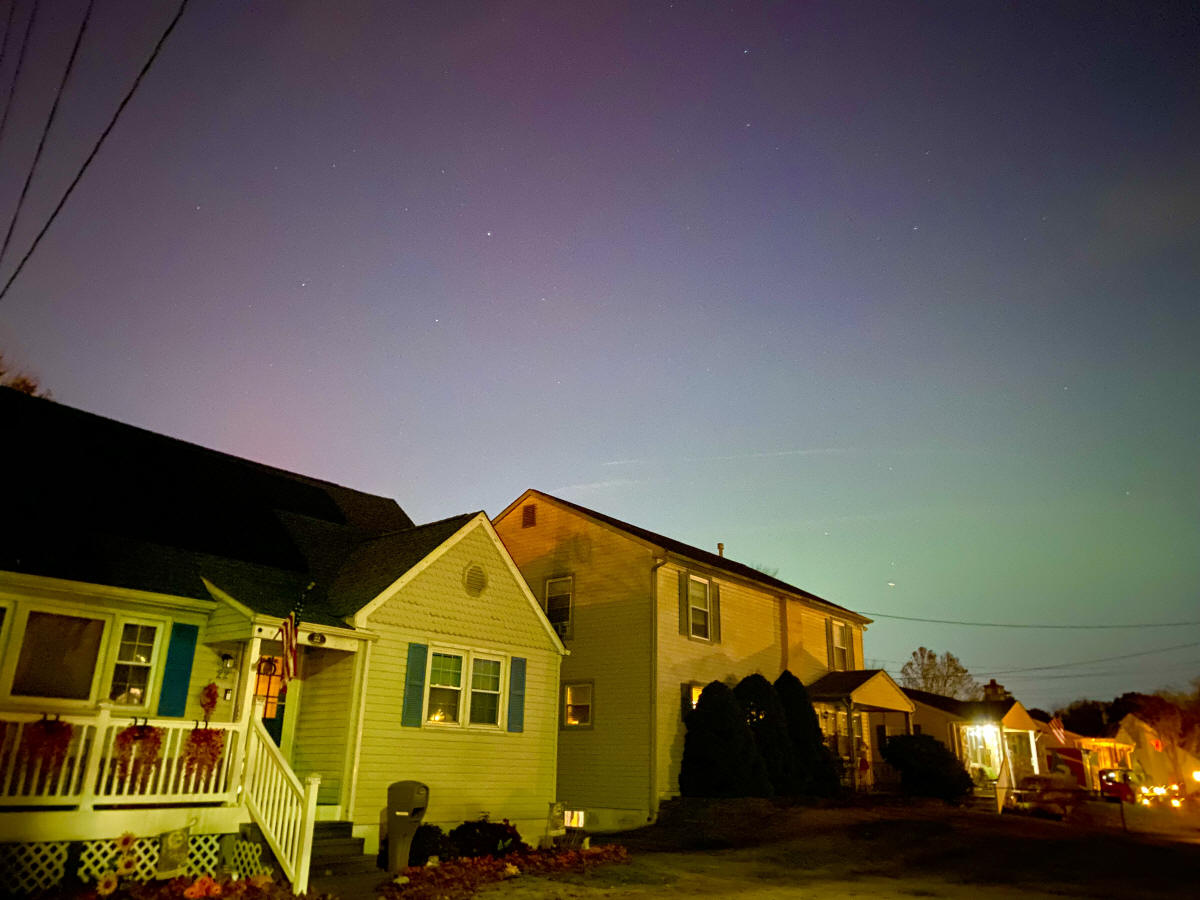
|
A pair of CMEs, Coronal Mass Ejections
(from the Sun) struck Earth on
November
11, 2025, as described at
Spaceweather.com. Alerted by multiple e-groups, I stepped
outside to my front yard in Maple Shade, NJ, for a look around
10:45 pm EST. Light pollution is significant here, so it was no
surprise that I didn't see anything. Then I took some handheld
snapshots with my iPhone 11. Some magenta and green auroral
color was visible, especially after increasing the saturation.
The picture above is looking towards the northwest and the
brightest visible star is Deneb in Cygnus, the Swan (one of the
vertices of the Summer Triangle lingering into the Fall).
Here's
another shot, looking north up the street. Polaris, the
North Star, is near the top almost straight above the middle
utility pole, while Kochab and Pherkad, the Guardians of the
Pole at the far end of the Little Dipper's bowl, are about
halfway up and a little left of a line from the utility pole to
Polaris. |
Comet C/2025 A6 (Lemmon)
with M10 & 12
November 4, 2025
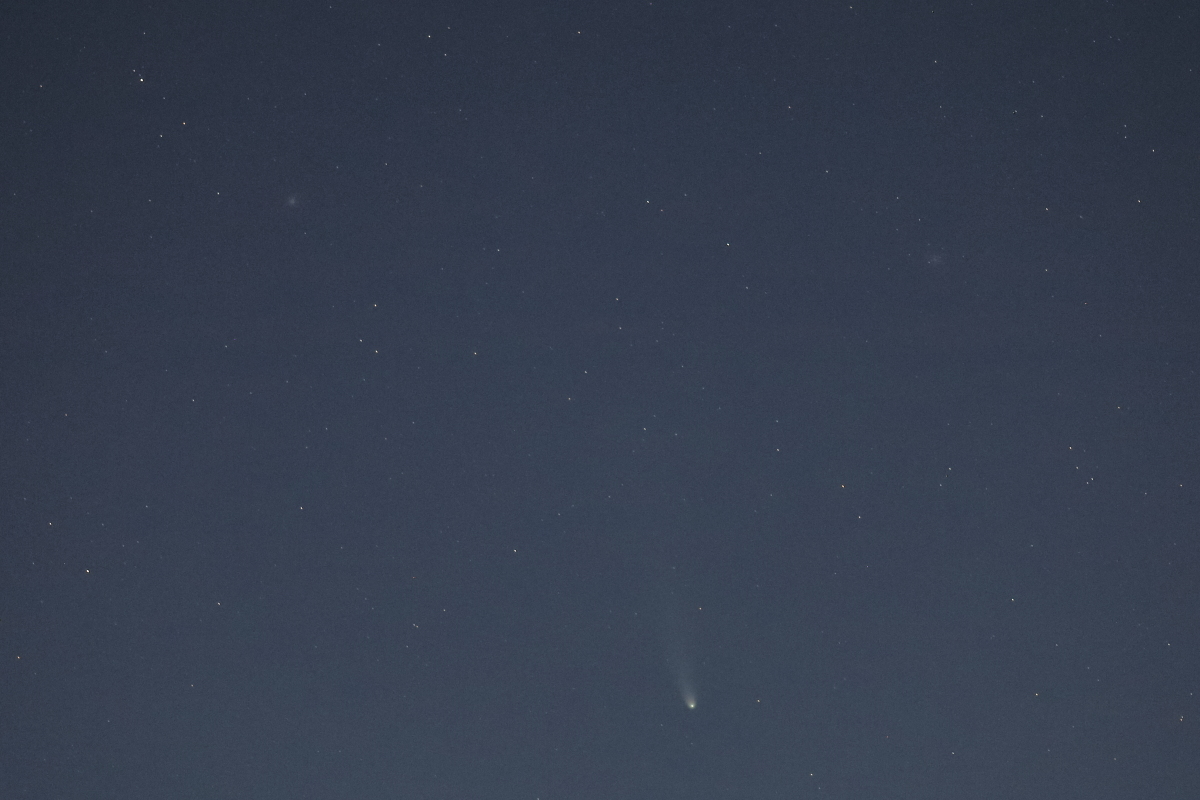
|
We made another trip to Atsion Field in Wharton State Forest,
NJ, on
November
4, 2025 to observe comet
C/2025 A6 (Lemmon), following up on our sessions on October
31 and November 3. On November 4, it
would be close to the globular clusters M10 and M12 in
Ophiuchus. I picked
up the comet with 12x50 binoculars at 5:41 pm EST, when it was
at 20.6° altitude in brightish twilight towards the
west-southwest,
48 minutes after sunset (4:53 pm) and 44 minutes before the end of
astronomical twilight (6:25 pm). The sky was entirely clear, but
there was a nearly full Moon at our backs (it would be exactly
full at 8:19 am on November 5).
When this picture was captured at 6:00 pm, Lemmon was at 17.3° altitude
and still in brightish twilight mixed with with light pollution
from Philadelphia and the intervening suburbs. A distinct short tail,
about half a degree long, was evident with the 12x50s,
but there was no sign of M10 or 12. A little later, with
mounted 18x70 binoculars, I was able to see a central
condensation in the coma and a tail about three-quarters of a
degree long (difficult to say for sure since it gradually fades
away). I was also able to see M10 & 12 with the 18x70s, albeit
rather faintly. As the
comet sank below 10° altitude, it became increasingly difficult
to see with either pair of binoculars, but especially with the
12x50s.
The image above is a single raw frame
taken at 6:00 pm with a Canon EOS RP DSLM camera and Canon 200
mm f/2.8L telephoto lens on a fixed tripod. It was manually exposed
1.6 seconds
at f/2.8, ISO 1600, daylight white balance. Using Canon's
Digital Photo Professional 4, it was lightly adjusted, cropped
to a field about 5.9°
wide x 4.0° high, then converted to this JPEG. M10 is 3.3°
above-left of Comet Lemmon, M12 is 2.6° above-right of it and
M10 & 12 are 3.3° apart. The brighter star in the upper-left corner is
magnitude 4.8, 30 Ophiuchi; the brighter star lower down near
the left edge is 23 Oph, mag 5.2. Mouseover for labels. I was
surprised these nominal 6+ magnitude clusters showed up at all
in this simple snapshot, in view of the twilight, light
pollution (both the Moon and man-made LP) and the low altitude.
Comet Lemon was about magnitude 4.5 based on contemporaneous
reports at COBS.
Here's a chart of Lemmon for November 8, 2025, 6 pm EST, +/-
eight days at two-day intervals (labeled
version). |
Comet C/2025 A6 (Lemmon)
October 27, 2025
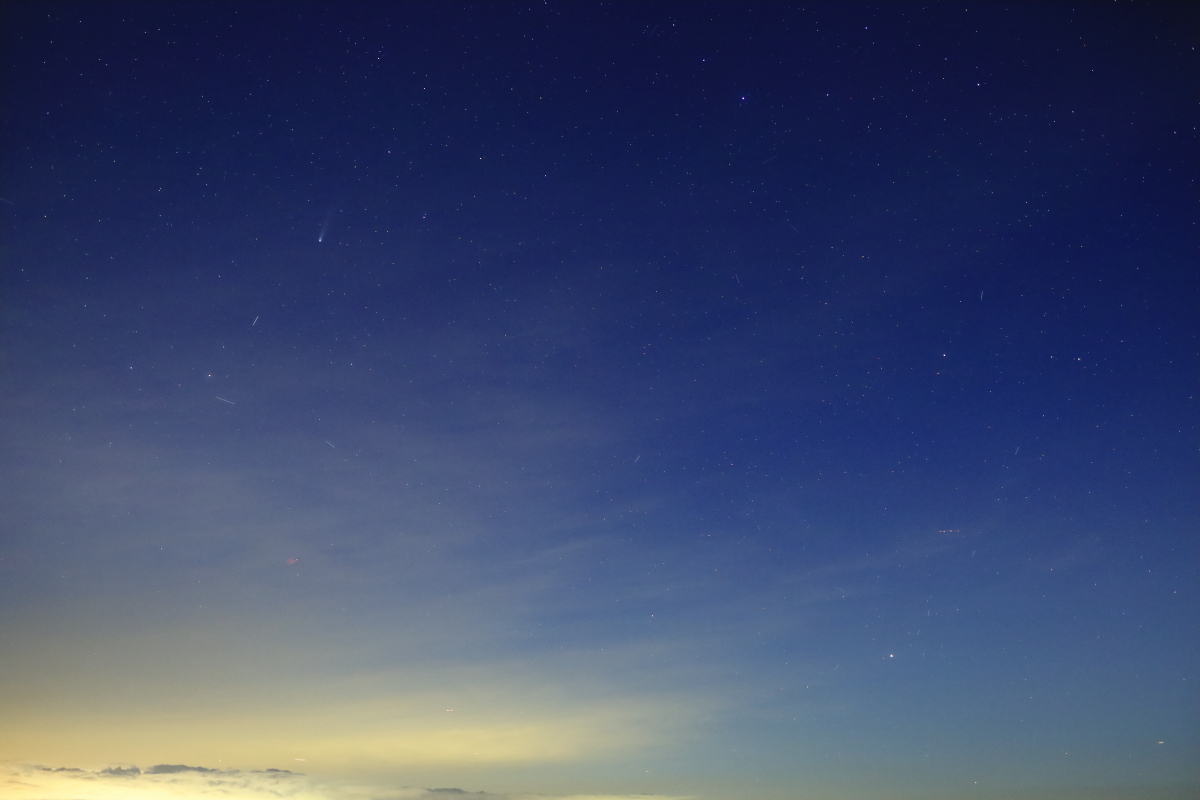
|
I went to Thompson's Beach, NJ, again on October
24, 2025 to observe comet
C/2025 A6 (Lemmon), hopefully with unaided eyes. I picked it
up at 6:50 pm EDT while still in brightish twilight, and as the
sky darkened, a distinct short tail was evident with the 12x50s;
sunset was at 6:05 pm and twilight ended at 7:34 pm. However, I
was unable to convincingly see Lemmon with unaided eyes due to
the presence of a 33% illuminated Moon and haze-like clouds
moving into the comet's area, as shown in the picture above. I
also spotted C/2025 R2 (SWAN) with the 12x50s, but it was more
difficult than October 24 at Carranza under a moonless sky.
This is a single raw frame
taken at 7:19 pm with a Canon EOS RP DSLM camera and a Sigma 50 mm, f/1.4
Art lens on a fixed tripod. It was manually exposed 2 seconds
at f/2.0, ISO 3200, daylight white balance. Using Canon's
Digital Photo Professional 4, it was lightly adjusted
and converted to this JPEG; it's
uncropped for a field about 40°
wide x 27° high. The comet is in the upper-left quadrant,
Arcturus is at the bottom-right and Alphecca is is near the
top-middle. Unfortunately, I just missed catching the recurrent
nova T CrB in the picture, but I did check the respective area
with the 12x50s and there was no sign of it. Mouseover for
labels.
Here's
a crop (labeled
version) of the upper left corner, about 23.5° wide x 15.8°
high, that better shows Comet Lemmon.
Shortly before sunset, at 5:44 pm,
I took a
snapshot of the clouds towards the west. Canon EOS RP + Sigma 20 mm f/1.4 Art lens,
handheld. Exposed automatically 1/250 second, f/5.6, ISO 100. It
was cropped vertically only to provide a 16:9 ratio for a field
84° wide x 54° high. |
Comet C/2025 A6 (Lemmon)
October 24, 2025
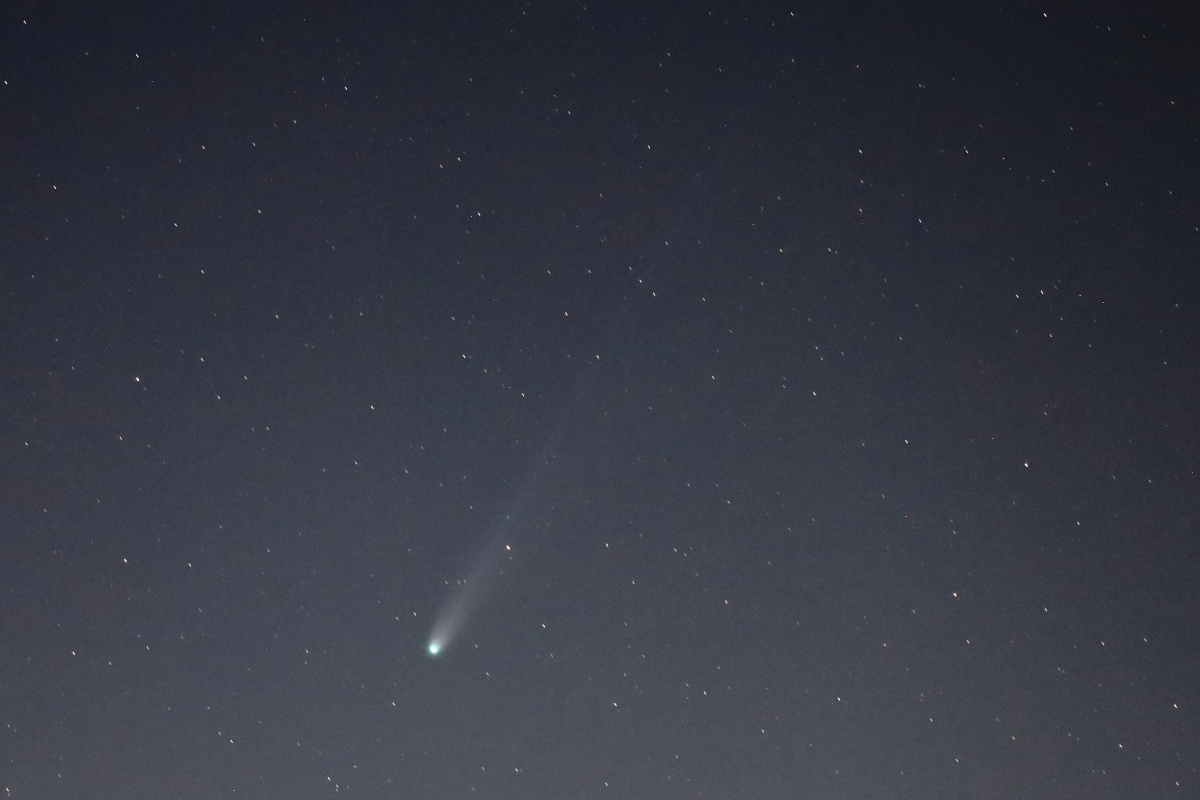
|
In the month of October, 2025, we were
blessed with two relatively bright comets in the evening sky,
C/2025 R2 (SWAN) and the comet pictured above,
C/2025 A6 (Lemmon). Both are easily visible now with
binoculars, and Lemmon is visible with unaided eyes from a
suitably dark location. SWAN is currently in the constellation
Aquila and Lemmon is in Serpens Caput. This snapshot of Lemmon
was captured at 7:28 pm EDT on October
24, 2025, from Carranza Field in Wharton State
Forest, NJ.
It's a single raw frame
taken with a Canon EOS RP DSLM camera and a Canon 200 mm, f/2.8L
telephoto lens on a fixed tripod. It was manually exposed 4 seconds
at f/2.8, ISO 3200, daylight white balance. Using Canon's
Digital Photo Professional 4, it was lightly adjusted, then
cropped
to 58% of the original linear dimensions yielding a field 5.9°
wide x 4.0° high, and converted to this JPEG. The tail extends
about 3° in this picture, and visually with 18x70 binoculars, nearly a
degree of tail was easily seen. The brighter star
above-right of the coma (about 39 arc min apart) is magnitude 5.7, HD 136138. |
The Crescent Moon, Venus and Regulus
September 19, 2025
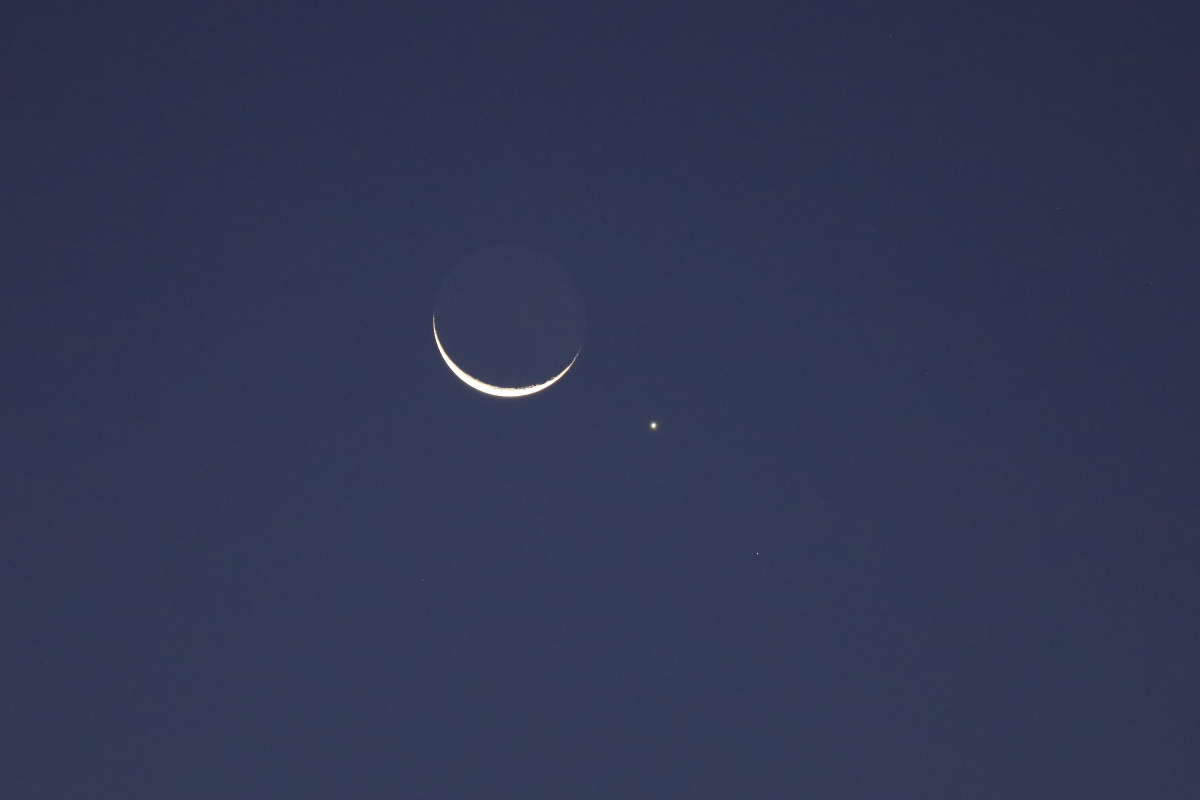
|
On the morning of September
19, 2025, the thin Crescent Moon, 5.5%
illuminated 2.4 days before New, passed close to the planet
Venus, which in turn was close to the first magnitude star
Regulus, in Leo.
At the time, the Moon was 36 arc minutes (0.60°) from Venus,
center-to-center, slightly more than the nominal 0.5° diameter
of the Moon. It was 33.5 arc minutes (0.56°) from Venus to
Regulus. Visually, they were a lovely sight, although Regulus
was overwhelmed by the bright Moon and Venus.
This snapshot was taken
at 6:15 am
EDT from Swede Run in Moorestown, NJ, with a Canon EOS RP DSLM camera and a Canon 400 mm, f/5.6L
telephoto lens on a fixed tripod. It was manually exposed 1/50 second
at f/5.6, ISO 3200, daylight white balance. Other than cropping
to 77% of the original linear dimensions yielding a field 3.95°
wide x 2.64° high, and size
reduction, the only post adjustment was setting white balance to
6000 K. Mouseover labels. |
Click here
for the previous page.
Click here
for an index to all previous SJAstro pages.







